– contributed by Museums & Archives Certiftcate Program student Katie Gable
I am in my final semester of undergrad and every so often I reminisce fondly on my time at The University of Akron. In four years, I have earned two degrees, my first in political science, the second in psychology, and a certificate in Museum & Archives. The skills I have learned inform my understanding of this project I have taken on.
To officially receive my certificate, I must complete a capstone project. Dr. Cathy Faye, executive director of the Cummings Center for the History of Psychology and Lizette Barton, a reference archivist in the Archives of the History of American Psychology presented to me the story of Gardner and Lois Murphy, a pair of psychologists who worked with UNESCO in India in the early 1950s. The goal: figure out the point of their trip, piece together the story and characters through photos in the archives, and eventually digitize and create metadata for the primary sources and photos I found. This project was perfect for my skill set. Expanding upon my knowledge of important psychologists and their work, improving upon my archival skills to solve “mysteries” and of course digitize, and lastly challenging my understanding of political and social tensions worldwide.
To summarize, Gardner and Lois Murphy were both well respected psychologists by the time they visited India. Gardner, who focused on social psychology, was an obvious pick to lead the UNESCO study, which focused on social tensions between Hindus and Muslims, following decolonization. After about a year of correspondence between Gardner and UNESCO’s social science head Robert Angell, arrangements were made for Murphy to spend a year in India working with Indian government officials, psychologists, anthropologists, university students, and more to gather data about the tensions being experienced (Murphy, 1953). However, Gardner would not agree without ensuring his wife, Lois B. Murphy, a child psychologist, could accompany him. In a letter to Angell, Gardner does not ask, but rather tells him that Lois should accompany him. He emphasizes Lois’s intentions to return to India insinutating that he could later join her on to “check up” on his initial UNESCO work. Lois was offered to be a consultant for the B.M. Institute of Child Development. During her time in India, she visited over 30 schools, orphanages, and organizations of all levels throughout the country (Murphy, 1967). As such, many of the photos I have come across in the archives so far are of young Indian children, some playing games, others sleeping, and my favorite image of a young girl holding a cat.
It could just be my bittersweet emotions towards graduating this May, but the research I’ve done thus far reminds me of being on a yearbook committee. Gathering photos of people and places, attempting to identify them, attempting to understand the cliques or rather groups that worked together. Even assigning superlatives, Lois and Gardner obviously winning “cutest couple” (I will now be holding my boyfriend to Gardner’s standard, expecting to be brought along on business trips, no questions asked). From the moment I realized these photos were not well labeled, I made space in my notes for a “UNESCO Yearbook” where I placed confirmed images of important people and places associated with the UNESCO study and compared them with photos from the archives.
The photo that inspired me to use the yearbook analogy for my research is a group photo of Gardner and some Indian men. The back is labeled with the name Pars Ram. I recognized that name from my research. Professor Pars Ram ran one of the six research teams assembled by Murphy for the study. His team was in charge of the Aligarh University study.
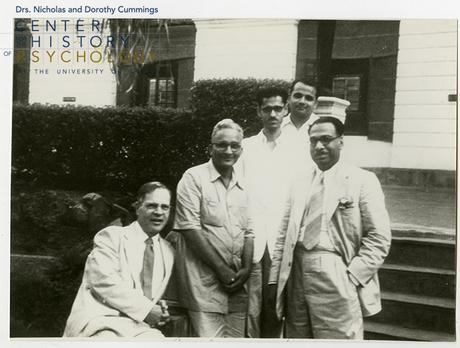
Gardner and Lois B. Murphy papers, box V40, folder 2
" data-orig-size="708,536" data-image-title="" data-orig-file="https://centerhistorypsychology.files.wordpress.com/2023/04/v40_2_front_001.jpg" data-image-description="" data-image-meta="{"aperture":"0","credit":"","camera":"","caption":"","created_timestamp":"0","copyright":"","focal_length":"0","iso":"0","shutter_speed":"0","title":"","orientation":"1"}" data-id="5748" data-medium-file="https://centerhistorypsychology.files.wordpress.com/2023/04/v40_2_front_001.jpg?w=300" data-permalink="https://centerhistorypsychology.wordpress.com/2023/04/05/why-dont-more-people-label-the-backs-of-photos-and-other-thoughts-working-in-the-archives/v40_2_front_001/" alt="Lois B. Murphy posing with four men in front of a building." class="wp-image-5748" data-large-file="https://centerhistorypsychology.files.wordpress.com/2023/04/v40_2_front_001.jpg?w=500" />Gardner and Lois B. Murphy papers, box V40, folder 2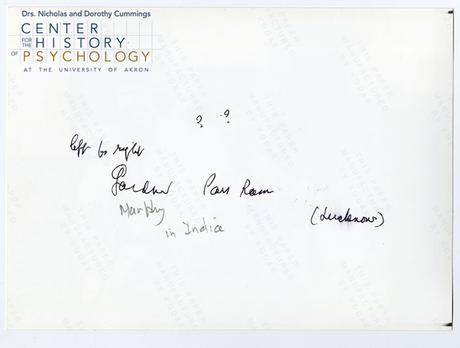
But which one of these men is Pars?
I turned to google to search his name to find any photos or information in general on him, but it’s scarce. I assume the lack of information can be attributed to the fact that he passed in 1952, a year after the study. So instead, I turn to the process of elimination. Maybe if I create a spreadsheet, no– a yearbook, of the “MVPs” in this study, important names that reoccur in the research, I can use the process of elimination to determine which one is Pars Ram and hopefully identify the other three men as well.
At the bottom of my notes, I list out every important name I have come across in my preliminary research. Out of around 20 names, I can only match 9 to photos I have been able to find on the internet. These photos on the internet are not necessarily trustworthy either. In some cases, I can only find one image of a person online and I have to hope for now that it is accurate. I laugh as my organization of these headshots and their names and titles in bold looks exactly like the staff directory page in my high school yearbook.
Desperate for answers, I decided to email Aligarh University to see if they can send me any more information about Pars Ram and hopefully a photo. Unfortunately, I received no response. Though my questions regarding this group photo still plagued me, I returned to the archives. Using the finding aid to identify any boxes with sources or photographs relevant to my research, I finally came across another photo of interest to me. It looked like a bit of an action shot, not posed like the one before, but even still I recognized the man. That man stands beside Gardner Murphy in the group photo. I turned the photo over, doubting it is labeled, but to my surprise, it is. In curly cursive is his name, “Pars Ram”!
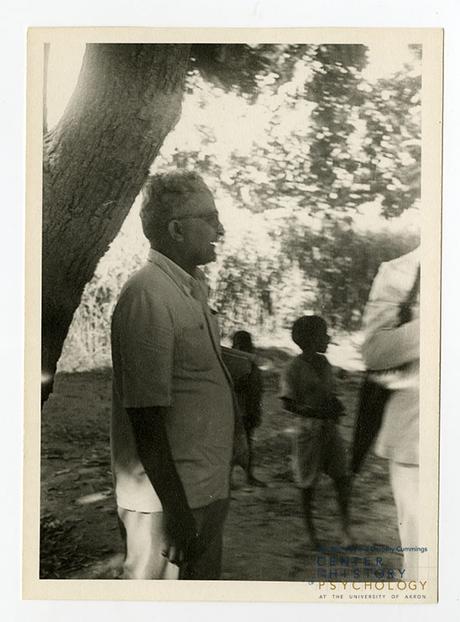
Gardner and Lois B. Murphy papers, box V61, folder 3
" data-orig-size="548,741" sizes="(max-width: 548px) 100vw, 548px" data-image-title="" data-orig-file="https://centerhistorypsychology.files.wordpress.com/2023/04/v61_3_front_036-copy-1.jpg" data-image-description="" data-image-meta="{"aperture":"0","credit":"","camera":"","caption":"","created_timestamp":"0","copyright":"","focal_length":"0","iso":"0","shutter_speed":"0","title":"","orientation":"1"}" data-id="5757" data-medium-file="https://centerhistorypsychology.files.wordpress.com/2023/04/v61_3_front_036-copy-1.jpg?w=222" data-permalink="https://centerhistorypsychology.wordpress.com/2023/04/05/why-dont-more-people-label-the-backs-of-photos-and-other-thoughts-working-in-the-archives/v61_3_front_036-copy-2/" alt="Pars Ram standing outdoors with a group of young children." srcset="https://centerhistorypsychology.files.wordpress.com/2023/04/v61_3_front_036-copy-1.jpg 548w, https://centerhistorypsychology.files.wordpress.com/2023/04/v61_3_front_036-copy-1.jpg?w=111 111w, https://centerhistorypsychology.files.wordpress.com/2023/04/v61_3_front_036-copy-1.jpg?w=222 222w" class="wp-image-5757" data-large-file="https://centerhistorypsychology.files.wordpress.com/2023/04/v61_3_front_036-copy-1.jpg?w=500" />Gardner and Lois B. Murphy papers, box V61, folder 3
Just when I thought my excitement was at an all time high, I came across a photo of another Indian man, characterized by his glasses and snazzy suit. This man is also in the group photo, I am certain. I compare the group photo with the individual photo to confirm. I turn it over and once again I am surprised to see it is labeled “H.P. Maiti”. I am now working extra hard to keep my excitement at a whisper level in the reading room. H.P. Maiti, is another important name I was unable to identify using online sources. Professor Maiti, the director of The Institute of Psychology Research and Service at Patna University also leads one of Murphy’s research studies.
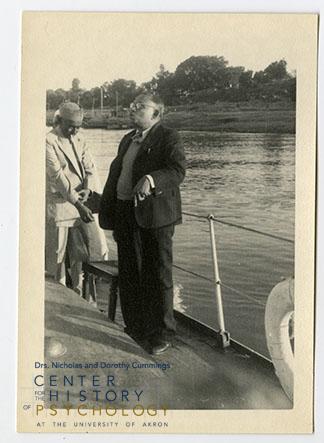
Gardner and Lois B. Murphy papers, box V31, folder 2
" data-orig-size="324,443" sizes="(max-width: 324px) 100vw, 324px" data-image-title="" data-orig-file="https://centerhistorypsychology.files.wordpress.com/2023/04/v31_2_front_001-1.jpg" data-image-description="" data-image-meta="{"aperture":"0","credit":"","camera":"","caption":"","created_timestamp":"0","copyright":"","focal_length":"0","iso":"0","shutter_speed":"0","title":"","orientation":"1"}" data-medium-file="https://centerhistorypsychology.files.wordpress.com/2023/04/v31_2_front_001-1.jpg?w=219" data-permalink="https://centerhistorypsychology.wordpress.com/2023/04/05/why-dont-more-people-label-the-backs-of-photos-and-other-thoughts-working-in-the-archives/v31_2_front_001-2/" alt="H. P. Maiti standing with another man standing at the edge of a pier or a boat." srcset="https://centerhistorypsychology.files.wordpress.com/2023/04/v31_2_front_001-1.jpg 324w, https://centerhistorypsychology.files.wordpress.com/2023/04/v31_2_front_001-1.jpg?w=110 110w, https://centerhistorypsychology.files.wordpress.com/2023/04/v31_2_front_001-1.jpg?w=219 219w" class="wp-image-5770" data-large-file="https://centerhistorypsychology.files.wordpress.com/2023/04/v31_2_front_001-1.jpg?w=324" />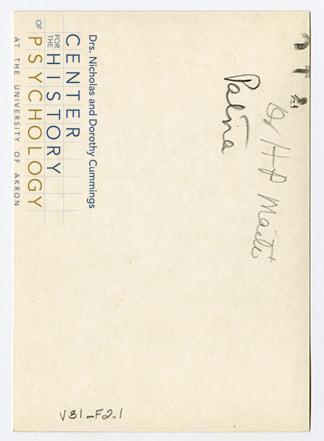
I have now identified two out of the four men positioned beside Gardner Murphy in the mysterious group photo. That leaves me with two more men to identify! Unsure of where to start, I refer to the initial group photo, which is labeled with the word “Lucknow” in addition to other scribbles and Pars Ram’s name. It must be referring to Lucknow University, another school involved with Murphy’s six team UNESCO study. This must be where the photo was taken and leads me to assume one of the two remaining men are Dr. Kali Prasad, the head of the Lucknow Study. However, similar to his peers, photographs of Prasad are not easily found on the internet.
I return to the archival boxes to find two folders, one of which has numbered photos from the UNESCO trip, the other descriptions of the numbered photos. I decide to read through the descriptions first, to see if there is anything that is of relevance to my research. Photograph 170’s description includes the name of Kali Prasad and I open the photograph folder full of hope and excitement, only to find those numbered photos end at 150. Disappointed and puzzled, I ask Lizette where they might be. A major aspect of working in the archives is processing collections. This means surveying, organizing, and creating finding aids. This work requires reevaluation and as a result boxes are reorganized, and folders rehomed. The Murphy Collection has been reorganized and so Lizette suggests I trace the two folders I found in the box back to where they may have been kept before. As of today, I have yet to find the photo of Dr. Kali Prasad or any images of him in general. However, I am not willing to give up just yet.
This is certainly more effort than my yearbook editor ever put in and I recall the spelling mistakes and incorrect labels that littered my senior yearbook. Good thing this is a capstone project that determines if I graduate certified in Museum & Archival studies and not an actual yearbook. With that in mind, I continue to scour the internet and archives.
References
Murphy, G. (1967). Gardner Murphy. In E. G. Boring & G. Lindzey (Eds.), A history of psychology in autobiography, Vol. 5, pp. 253–282). Appleton-Century-Crofts. https://doi.org/10.1037/11579-010
Murphy, G. (1953). In the minds of men: The study of human behavior and social tensions in India. Basic Books/Hachette Book Group. https://doi.org/10.1037/11234-000
